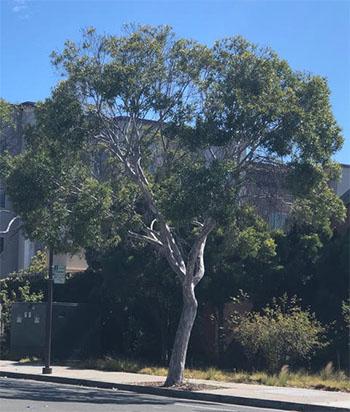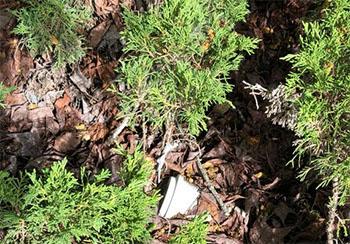Summer 2022
Living with Wildfire - Firescaping Plant Lists

Fire departments are now doing inspections of vegetation! Contact your local fire department for local requirements.
Firewise Plant Lists are being removed from websites by many Firesafe Councils and Wildfire Preparedness agencies. This movement has occurred because these lists were often based on anecdotal evidence, “just a feeling," and often wholesale prejudice against (or for) entire categories of plants. In addition the lists often confused “fire resilient” with “fire resistant”—a critical difference. A fire resilient plant can be highly flammable and capable of spitting sparks and burning at high temperature, but can come back to life quickly, usually by crown sprouting. A fire resistant plant, on the other hand, is slow to catch fire, traps embers among hydrated leaves, often letting the embers die out, or, if the plants burn, they turn into ash, without propagating either embers or high heat flames.
Responsible firescape educators realized that there was a need for a standardized system for assessing the fire risk of various plants. There has been no uniform testing process defined and accepted by researchers. Plus additional factors not having to do with the plants themselves can make higher fire risk plants safer, and lower fire risk plants more dangerous. In the end, choosing plants wisely for the firescape has everything to do with how well a gardener can water, site and maintain those plants.
While revising the plant lists with a more critical eye, dropping those where there is uncertainty and consulting with fire and botanical experts, groups are instead prescribing how to evaluate whether a plant is highly flammable and spits sparks, or likely to simply turn to ash. Firesafe Marin has recently revised their decision-making process for selecting plants, based on advice from UCCE staff Yana Valachovic, Stephen Quarles and Steven Swain who all specialize in wildfire preparedness. This thoughtful process includes maintenance factors that, if the gardener can’t maintain a plant in a timely manner during wildfire season, lead to the wise decision whether to grow certain plants, or keep or remove an existing plant.
- Are the plant’s leaves high in moisture, and therefore less likely to ignite? The leaves of plants that grow in vegetable gardens, for example, are high in moisture.
- Does the plant contain a lot of waxes, oils, and resins? The leaves of waxy and oily plants have a protective shine or film that will likely be more flammable and release more energy when they burn; resinous plants include many conifers.
- Does the plant have an open-growth structure? A more densely structured plant, like a juniper or cypress, can capture embers and may be more likely to ignite, especially if the densely structured areas of the plant consist of dead and fine fuels. A densely structured plant is also more likely to ignite from a surface fire.
- Does the plant accumulate dead branches, needles, leaves? A plant with a big leaf or needle drop creates a greater need for cleanup around the property, on the roof, and in rain gutters.
- Does the plant shed bark? A plant that sheds bark or branches is likely to need more regular cleanup to reduce fuel accumulations on the ground.
- How fast does the plant grow? How tall will the plant grow? A plant that grows quickly may exceed growth expectations and require greater maintenance.
Firesafe Marin has also just posted a new list of fire-resistant and highly flammable plants.
Balancing acts. In a recent wildfire talk, new preliminary forestry research shows that the leaves of the Eucalyptus globulus, known as blue gum, do not catch fire easily while they’re on the tree. Yet the leaves, after they fall to the ground, will dry out and the oils become accessible to embers and catch fire easily. This closer examination was done after several observations of eucalyptus forests surrounding WUI development suffering minimal damage at the periphery—while entire communities of homes burned down. This suggests that if a home owner has a huge eucalyptus—costly to remove, an effective storage of carbon which is released to the atmosphere if it is cut down, and a rich element in the local ecosystem, especially for winter-time pollinators—they could opt to limb up to 12 feet (or more), open up the tree, strip loose bark (the trunk underneath is resistant to fire), and consistently remove ground-level loose debris (might be daily during red flag days; a serious commitment). Pruning every 2–3 years usually can maintain the thinning and bark stripping. Some supplementary water in summer, while not essential to the health of the tree except during extended drought, will reduce leaf drop and the resulting maintenance. However, this careful maintenance program still won’t make this tree safe enough if its canopy is within 30 feet of your home. And not everyone can afford either the time or the funds to keep up with the work.

Fire-foolish. Still, there are plants nobody can maintain safely in the defensible zone around one’s home (0–150 feet). Pine tree needles fly far away and year-round, filling gutters, piling on decks or dormers, sticking to spider webs on wooden fences or sheds for hundreds of feet around. Junipers, with inherently pitchy, oily foliage and shredding bark, continually shed duff that catches fire instantly. Worse, those oils promote hotter fire flames and generate sprays of sparks high into the air. These plants are likely to turn up on banned plant lists for defensible zones around structures as more jurisdictions expand vegetation management regulations.
Article by Marilyn Saarni, UC Master Gardener of Contra Costa County
Photo courtesy: Marilyn Saarni
Photo courtesy: Marilyn Saarni
